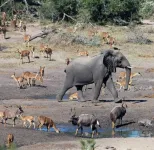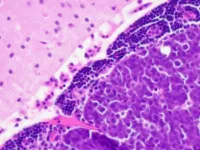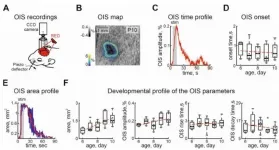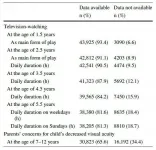(Press-News.org) Elephants and lions are iconic species that help raise substantial funds for conservation. However, they also pose significant threats to people, crops, and livestock, and are themselves threatened with extinction.
Areas at severe risk are identified
In a new article published in the journal Nature Communications, scientists have identified the areas that are most at risk for conflicts between humans and elephants and lions in Africa. They also estimated the associated return on investment of building and maintaining high-quality fences, which are used to reduce conflict between humans and wildlife.
Associate Professor Enrico Di Minin, who is the lead author of this article and leads the Helsinki Lab of Interdisciplinary Conservation Science at the University of Helsinki, highlights that human pressure on elephants and lions is extremely high.
"We found that 82% of sites containing lions and elephants in Africa are adjacent to areas with considerable human pressure", says Di Minin.
"Areas at severe risk of conflict (defined as areas with high densities of humans, crops, and cattle) comprise 9% of the perimeter of these species' ranges and are found in 18 countries hosting, respectively, ~ 74% and 41% of African lion and elephant populations", he continues.
African forest and savanna elephants have recently been classified as Critically Endangered and Endangered in the IUCN Red List of species, while African lions are classified as Vulnerable. Human activities pose the greatest threats to these species, particularly retaliatory killings of lions in response to livestock losses and of elephants in response to crop damage. Elephants and lions also kill dozens to hundreds of people each year.
"We found that elephants and lions are now most abundant at localities where human population density is lowest. At a national scale, lion populations are higher in countries where funding for conservation is higher and elephant numbers are higher in countries with higher gross domestic product per capita", states Professor Rob Slotow from the University of KwaZulu-Natal in South Africa
"We also found that areas at high risk of conflict are especially found in East and West Africa", he continuous.
Benefits of mitigation fences
Although a variety of conflict mitigation strategies could be deployed to address human-wildlife conflict, the team has assessed the return on investment of deploying high-quality mitigation fences, which have been found to be effective in reducing human-wildlife but are very expensive to build and maintain.
"Our results show how mitigation fences would provide considerable return on investment via reduced cattle loss and crop damage, especially in Tanzania, Ethiopia, and Kenya", says Professor Craig Packer from the University of Minnesota in the US.
"Our analysis reveals the location of about 10,000 kms of protected-area boundaries immediately adjacent to landscapes with such high densities of people, farmland and cattle pastures that wildlife movements have already been largely blocked. Mitigation fencing would merely reflect the reality of conserving large, dangerous, wildlife species in the Anthropocene. More and more African countries are starting to rely on mitigation fencing to better protect their citizens from the most dangerous wildlife species.", he continues.
The authors highlight how attention should be paid to prevent further habitat fragmentation for any migratory species that still manage to traverse the worst affected areas and to carefully consider the values, preferences, and motivations of local people before building mitigation fences.
"However, areas of intensive human pressure already produce hard boundaries around remaining areas of natural habitat and bold strategies to conserve these species are immediately needed, especially as human pressure will increase in the future with Africa experiencing very high human population growth by the end of the century", concludes Associate Professor Enrico Di Minin.
INFORMATION:
Article reference:
Di Minin, Enrico; Slotow, Rob; Fink, Christoph; Bauer, Hans; Packer, Craig. A pan-African spatial assessment of human conflicts with lions and elephants. Nature Communications doi: 10.1038/s41467-021-23283-w. https://www.nature.com/articles/s41467-021-23283-w
More information:
Dr Enrico Di Minin, Associate Professor of Conservation Geography, Helsinki Lab of Interdisciplinary Conservation Science, Department of Geosciences and Geography, University of Helsinki
Email: enrico.di.minin@helsinki.fi
Phone: +358(0)294150770
Twitter: @EnTembo; @HELICS_Lab @helsinkiuni
Great tits living in cities are genetically different from great tits in the countryside. This is what researchers have found in a unique study, where they examined populations of great tits in nine large European cities.
The researchers compared the city bird genes with the genes of their relatives in the countryside. It did not matter if the great tits lived in Milan, Malmö or Madrid: in order to handle an environment created by humans, the birds evolved in a similar way.
Different gene types linked to important biological functions such as cognition and various behaviours regulated by serotonin, including aggression and circadian rhythms, were found to have been selected and passed on from generation to generation. In rural populations, these behaviours are also ...
When the United States issued national stay-at-home guidelines in March 2020 in response to the COVID-19 pandemic, mobility across the country dropped significantly. New research from the Harvard John A. Paulson School of Engineering and Applied Sciences (SEAS) demonstrates that people may be inclined to change their behavior in response to national guidelines, more than state and local policies.
"When the next pandemic hits, we need to know what kind of policies are going to have the biggest impact on human behavior and health," said Marianna Linz, Assistant Professor of Environmental Science and Engineering and of Earth and Planetary Sciences at SEAS and senior author of the paper. "While specific, local ...
Two experimental drug approaches that target vulnerabilities in cancer cell metabolism may extend survival and enhance the effectiveness of standard chemotherapies for a highly aggressive type of pediatric brain cancer.
The findings were reported by Johns Hopkins Kimmel Cancer Center researchers in two published studies.
Medulloblastoma is the most common malignant pediatric brain tumor. A subset of patients with tumors known as Group 3 MYC-amplified medulloblastoma have an overall survival rate of less than 25%. In these patients, the cancer-promoting MYC oncogene drives cancer cell growth by altering cancer cell metabolism. Cancer cells use energy in ways that are different from normal cells, ...
Researchers in China, Japan, and Singapore were able to resume research much quicker than their counterparts in the US and Europe after the first covid lockdowns, results of a new international survey suggest.
Published 'Open Access' in the peer-reviewed journal Science and Technology of Advanced Materials, the findings of the 'Survey on the effects of the COVID-19 pandemic on research activities of materials scientists', which also included a series of podcasts with eminent experts, highlight how severe the impact of lockdowns affected researchers internationally.
33% of respondents had to shut down all equipment.
The outcomes were not uniform internationally however, as whilst labs in the UK and parts of the USA, Spain, and India were not accessible ...
DURHAM, N.C. -- Researchers have discovered a new coronavirus, found in a child with pneumonia in Malaysia in 2018, that appears to have jumped from dog to human.
If confirmed as a pathogen, the novel canine-like coronavirus could represent the eighth unique coronavirus known to cause disease in humans. The discovery also suggests coronaviruses are being transmitted from animals to humans more commonly than was previously thought.
"How common this virus is, and whether it can be transmitted efficiently from dogs to humans or between humans, nobody knows," said Gregory Gray, M.D., a professor of medicine, ...
Study lead, Research Associate of the Neurobiology Lab Marat Minlebaev explains, "Our brain is a complex mechanism, and it's important to understand how it works. If we understand how our brain functions, we can put forth new treatment methodologies or prevent pathologies, both congenital and acquired."
A number of techniques were used to undertake the research, so, apart from biologists, other scientists were also invited to partake.
"Fourth year students Viktoria Shumkova and Violetta Sitdikova conducted experiments and analyzed their results," says Minlebaev. "To implement the idea, new software was ...
Researchers from Russia and Germany have created a genome-wide atlas of developmental alternative splicing changes of seven organs in six mammal species and chicken.
The research was published in the journal Nature Genetics.
As the protein encoding RNA matures in eukaryotes, it gets spliced, with some parts cut out and the remaining fragments stitched together. Alternative splicing means that the same RNA fragment can either be cut out from or kept within the mature RNA. In this case, one gene can encode several RNAs and, therefore, several proteins. Although alternative splicing is known to be essential for many tissues to develop and function properly and its various disorders may cause health problems, ...
It is ingrained in parents to curtail the hours their children spend in front of the television. Anecdotal evidence suggests that prolonged viewing of television and use of smart gadgets during early years can adversely affect a child's eyesight and behavioral development. However, there is little scientific evidence to support such observations on the effects of excessive television exposure on children's visual acuity. Now, Professor MATSUO Toshihiko (M.D., Ph.D.) and Professor YORIFUJI Takashi (M.D., Ph.D.) from Okayama University describe how such exposure can indeed have detrimental effects on children's eyesight during later years.
The researchers used a national database of the Japan Government, based on the annual survey of all children born in the certain period of the ...
Nerves release a protein at the injury site that attracts growing nerve fibers and thus keeps them entrapped there. This prevents them from growing in the right direction to bridge the injury. The research team headed by Professor Dietmar Fischer reports in the journal Proceedings of the National Academy of Sciences (PNAS) from 25. May 2021.
There must be another cause
Three main causes for the inability of injured nerves of the central nervous system, or CNS, to regenerate have been known to date: the insufficient activation of a regeneration program in injured nerve cells that stimulates the growth of fibers, so-called axons; the formation of a scar at the site ...
TROY, N.Y. -- Heart disease and cancer are the leading causes of death in the United States, and it's increasingly understood that they share common risk factors, including tobacco use, diet, blood pressure, and obesity. Thus, a diagnostic tool that could screen for cardiovascular disease while a patient is already being screened for cancer, has the potential to expedite a diagnosis, accelerate treatment, and improve patient outcomes.
In research published today in Nature Communications, a team of engineers from Rensselaer Polytechnic Institute and clinicians from Massachusetts General Hospital developed a deep learning algorithm that can help assess a patient's risk of cardiovascular disease ...



